FTC Disclosure: If you make a purchase via a link on this site, We may receive a small commission on the transaction - at no added cost to you. Thank you!
Ruby-throated Hummingbird
Gem of the East
The Ruby-throated Hummingbird (Archilochus colubris) is one of the most numerous and widespread hummingbird species of North American.
Easy to identify, the ruby red gorget (throat) of the male makes the bird instantly recognizable and named the Ruby-throat for this distinguishing feature.
There are many more species of hummingbirds but many Easterners consider the Ruby-throat as the only hummingbird because of their dominance here.
Despite its’ expansive range, it is the only hummingbird to breed east of the Mississippi River.
Ruby-throated Range
Summer Range:
Canada - from central and southern Alberta to central Saskatchewan, southern Manitoba, southern Ontario, southern Quebec, New Brunswick, Prince Edward Island and Nova Scotia.
United States - from Minnesota, Iowa, central Kansas, Oklahoma and Eastern Texas east to all the states on the Atlantic.
Winter Range:
Most Ruby-throated hummingbirds spend their winters in Mexico and Central America.
Some, however, inhabit Florida, Florida Keys, Georgia, and the Gulf Coast of Louisiana and Texas all year long.
In recent years there have been an increasing number of wintering hummingbird sightings in other southern states.
It is unclear if
these Ruby-throated hummingbirds are learning to adapt to changing climate
conditions or are genetically different from those that migrate.
Hummingbird Identification
Length: One of the most endearing qualities of our
Ruby-throated hummingbird is its’ small and compact size of only 3 ¾ inches (An
interesting fact-This hummingbird is the smallest except for the Bee hummingbird.
Wingspan: Only 4 ½ inches but we can note that the wingspan of the female is slightly larger than that of the male.
Tail feathers: The tail feathers of the male are long and deeply notched. The tail feathers of the female are more moderately notched or somewhat rounded.
Distinctive Markings
Adult male - Our exquisite Ruby-throated hummingbird is famous for its iridescent feathers.
If you look at a male without any reflection from the sunlight, its feathers will look black.
This is because they do not contain the pigments of color. In the sun, they reflect the light and we see that the gorget (throat) is ruby red bordered by a narrow band of black.
To add to the beauty, a white breast extends around the sides of the neck and contrasts with the white gorget.
All this is set off with a lovely metallic green back and wouldn’t you know a green head crown. What a prince!
Only the male has a radiant ruby red throat (gorget).
Adult female: The female beauty lacks any red gorget and there might be some dusky color on the throat. Its back is basically bright green. The sides are a kind of grey-green.
The female has a dull white throat and a white rounded tail.
Immature male: We always notice how much smaller they are.
An immature male resembles an adult female with a shorter bill. (These young hummingbirds are definitely more friendly to humans.
We marvel at their innocence as they fly in front of our windows asking for us to fill the feeders. They really do act a bit like children.)
Immature female: Again this bird is smaller than the adult female but does resemble one.
Habitat
We welcome our Ruby-throated hummingbirds in our backyards at our flowers and feeders.
For this reason, we often forget they are woodland birds that can found in our forests.
Whether in our yards or in the woods, these birds require a nectar source, a water source, and insects such as aphids, caterpillars, and mosquitoes.
In winter most migrate to South and Central America for a suitable food source and climate. We are always sad to see them leave and wishing them a safe journey.
Behavior
Mating: The work of the male is to migrate first and find a territory for the females to nest. The males mate with several females chosen by the females based on nesting territory.
They perform an astonishing diving mating ritual dance to entice these females.
Nesting: The females build the nests out of ferns, young leaves, mosses, or downy fibers of trees in oaks, maples, poplars, pines or spruce trees.
She typically has 2 eggs and raises the young alone with no help
from the male. More about nesting here.
Memory: These birds have a large brain for their size and as long as they journey safely remember to return to the same feeders each year.
Eating habits: They are attracted to red feeders and colorful flowers due to great eyesight. Here they find the nectar they need for energy.
They perch on tree branches and wait for insects to eat for protein.
More about hummingbird food here.
Sounds: They make a rapid series of chirping sounds. More about sounds here.
Social: These birds are highly territorial and consider all other hummingbirds and some other birds as rivals.
Oh, how we watch then fight off another hummingbird. There are things we can do when hanging our feeders that can help maintain a bit of peace and encourage more hummingbirds to visit us.
Near migration there is some deviation from the normal aggressiveness toward one another.
You might see several hummingbirds sharing a feeder at once. At this time of year, they are desperate to fuel up for migration and need to double their body weight in just a few weeks.
Besides, many juveniles are now using the same feeders as well. So sharing takes precedence over territorial fights but only temporarily in the autumn.
Migration: They arrive in the early spring and depart in the autumn.
We certainly respect our Ruby-throated hummingbirds for making a non-stop flight across the Gulf of Mexico.
To learn more about migration, click here.
Migration and Breeding Range map of the Ruby-throated Hummingbird.
Map provided by Cornell Lab of Ornithology
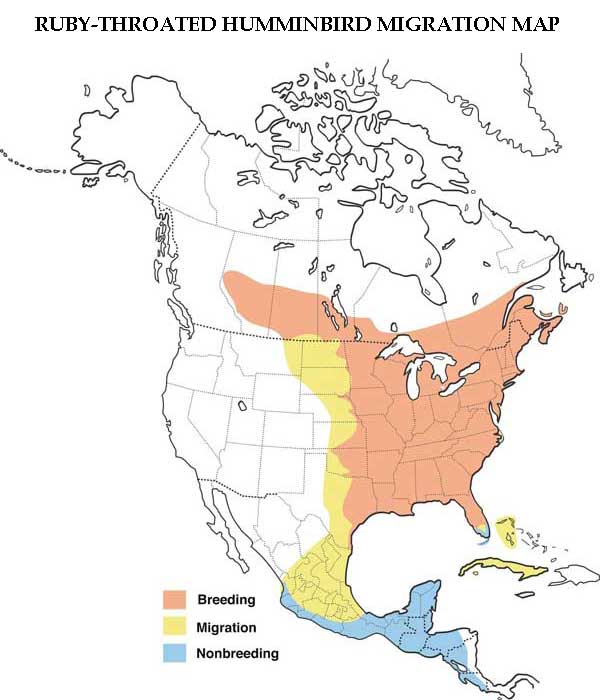
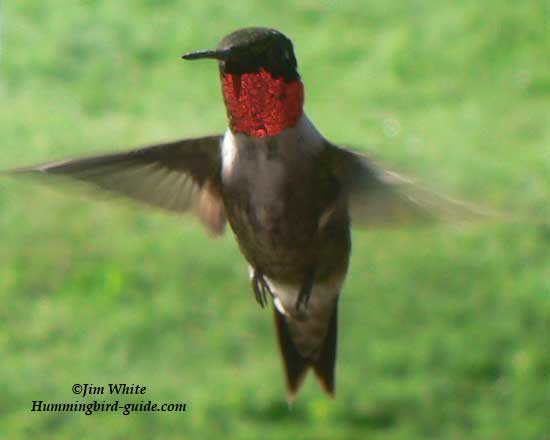
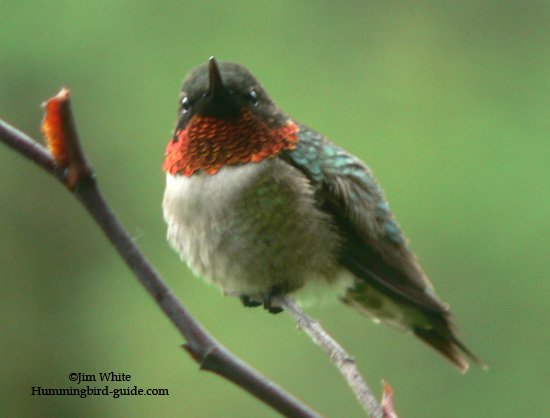
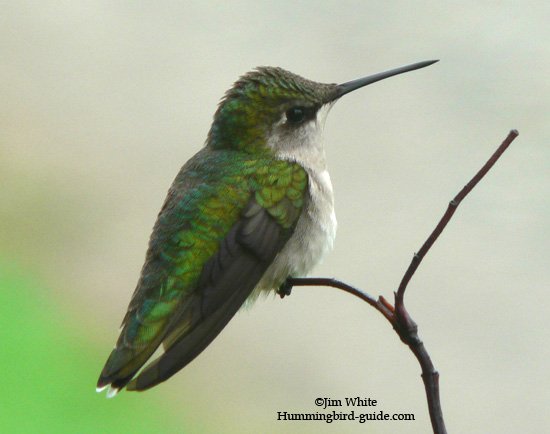
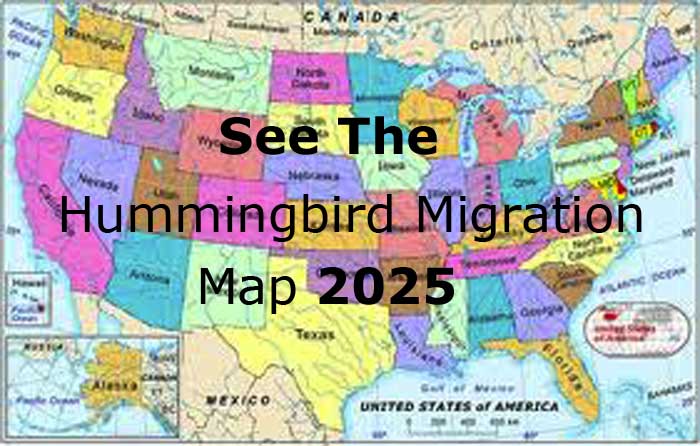

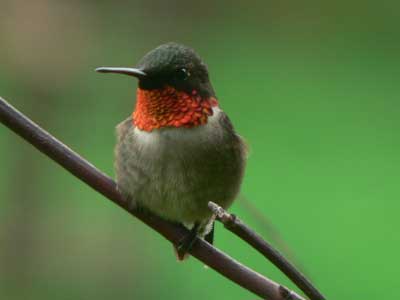






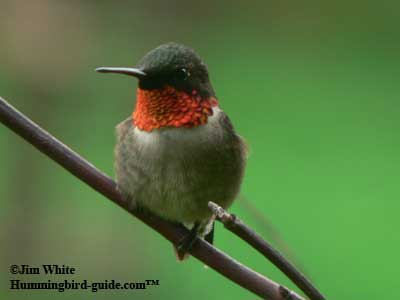
New! Comments
Have your say about what you just read! Leave me a comment in the box below.